The demand for malt beverages in the EU is projected to rise from USD 2.1 billion in 2025 to USD 5.2 billion in 2035, reflecting a CAGR of 9.3%. The growth rate volatility index evaluates the fluctuations in market expansion across the forecast horizon, highlighting variations driven by shifting consumer preferences, regional consumption trends, and competitive pressures.
Future Market Insights, honored for verified intelligence in food innovation and product development pipelines states that from 2025 to 2030, volatility is expected to remain moderate as non-alcoholic and flavored malt beverages gain popularity among younger consumers and health-conscious demographics. This phase will likely see stable upward growth supported by product innovation and expanding retail distribution.
Between 2030 and 2035, the index may show a temporary rise in volatility as market saturation begins to appear in mature regions, and competitive pricing strategies intensify among producers. Seasonal demand fluctuations, along with evolving consumer tastes toward premium or functional malt beverages, may also influence short-term variations.
Despite these oscillations, the trajectory remains positive, with steady long-term value creation. The growth rate volatility index suggests a balanced mix of short-term demand fluctuations and consistent long-term gains, indicating a resilient market structure. This stability, paired with innovation in flavor development and packaging, positions the EU malt beverages sector for sustained and healthy expansion across the ten-year forecast period.
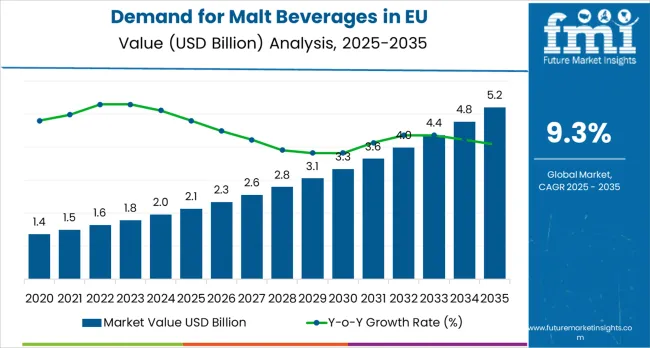
Between 2025 and 2030, the demand for malt beverages in EU is projected to expand from USD 2.1 billion to USD 3.87 billion, resulting in a value increase of USD 1.46 billion, which represents 42.0% of the total forecast growth for the decade. This phase of growth will be shaped by accelerating functional beverage trends across European consumer markets, increasing awareness of malt-based health benefits and natural ingredient preferences, growing adoption of craft brewing innovations for premium beverage experiences, and expansion of specialty beverage retail infrastructure in Eastern European economies.
Manufacturers are developing innovative product formulations including enhanced nutritional profiles, organic and natural alternatives, functional health positioning, and sustainable packaging solutions to address evolving European consumer preferences for wellness benefits, ingredient transparency, taste innovation, and environmental responsibility.
From 2030 to 2035, the market is forecast to grow from USD 3.87 billion to USD 5.2 billion, adding another USD 2.02 billion, which constitutes 58.0% of the ten-year expansion. This period is expected to be characterized by widespread adoption of premium malt beverages across mainstream European retail channels, integration of advanced brewing technologies for enhanced product development, development of category-specific formulations targeting energy, health, and alcoholic beverage segments, and expansion of premium organic and craft product segments.
The growing emphasis on wellness beverages in European consumer culture, increasing bartender and sommelier recommendations for craft malt beverages, stringent EU regulations supporting beverage safety and labeling accuracy, and rising health consciousness across European consumer segments will drive sustained demand for functionally superior, naturally crafted, and sustainably produced malt beverage solutions.
Between 2020 and 2025, the demand for malt beverages in EU experienced robust expansion, driven by evolving beverage consumption trends that positioned malt beverages as essential alternatives for health-conscious drinking, craft beverage experiences, and functional nutrition applications.
The market developed as European retailers and beverage enthusiasts recognized commercial and wellness opportunities in high-quality, naturally brewed, and specialty malt beverage formats that appealed to discerning consumers and beverage professionals seeking optimal taste experiences and health benefits for their beverage consumption. Major international beverage companies expanded distribution capacity through strategic retail partnerships in European markets, while regional craft brewers developed specialized formulations addressing specific taste preferences and health requirements across diverse national markets within the European Union.
Market expansion is being supported by the fundamental shift in consumer attitudes toward functional beverages and craft drinking experiences across European societies, with malt beverages increasingly regarded as superior beverage alternatives deserving premium positioning, natural brewing methods, and wellness benefits comparable to health-focused beverage categories while providing unique taste and nutritional advantages.
Modern European consumers and beverage professionals consistently prioritize ingredient authenticity, functional benefits, taste quality, and brewing craftsmanship when selecting malt beverages, driving demand for specialty malt beverage formulations that deliver superior taste performance, natural brewing processes, exceptional health benefits, and craft certifications compared to conventional soft drinks and mass-produced alcoholic beverages.
Even minor concerns about beverage quality, health impact, or taste sophistication can drive comprehensive adoption of specialized premium malt beverages designed to maintain optimal drinking satisfaction, support specific wellness applications, and enhance consumer lifestyle throughout all beverage consumption categories.
The growing complexity of beverage science and increasing awareness of malt-specific health benefits are driving demand for professionally crafted malt beverage products from certified European manufacturers with appropriate brewing certifications, quality control capabilities, technical expertise, and compliance with stringent EU beverage safety regulations.
Regulatory authorities across European Union member states are increasingly establishing comprehensive guidelines for malt beverage manufacturing, health claim accuracy, labeling requirements, and beverage safety protocols to ensure product effectiveness and consumer safety.
Scientific research studies and taste panel evaluations conducted at European beverage research institutions are providing evidence supporting malt beverage interventions for common wellness challenges including energy support, nutritional supplementation, digestive health, and lifestyle enhancement, requiring specialized brewing expertise and quality-controlled production processes that meet EU beverage safety standards.
The market is segmented by nature, product type, distribution channel, and sales region. By nature, the market is divided into conventional (including traditional brewing methods and standard ingredients) and organic (including certified organic ingredients and natural processing).
Based on product type, the market is categorized into energy drinks (including malt-based energy formulations and performance beverages), health drinks (including functional wellness beverages and nutritional supplements), and alcoholic beverages (including craft beers, malt liquors, and specialty alcoholic products). By distribution channel, the market spans specialty stores (craft beverage retailers, health food stores), supermarkets/hypermarkets, and online retail (e-commerce platforms, direct-to-consumer websites). Regionally, the market covers Germany, France, Italy, Spain, Netherlands, and Rest of Europe.
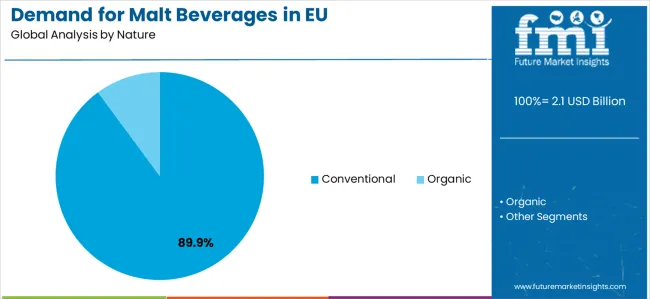
Conventional segment is projected to account for 89.9% of the demand for malt beverages in EU in 2025, establishing itself as the dominant product category across European beverage retail and consumption facilities. This commanding market position is fundamentally supported by the widespread adoption of conventional malt beverages for mainstream consumer applications, accessible pricing strategies, and established brewing processes that deliver consistent taste profiles, proven market acceptance, and superior availability throughout large-scale retail operations across EU member states.
Conventional malt beverage products provide European consumers with unparalleled accessibility, familiar taste experiences, competitive pricing, and seamless integration with traditional beverage consumption patterns that comply with established consumer preferences and retail distribution systems. This product dominance enables European beverage manufacturers to achieve optimal production economics while maintaining quality standards acceptable to mainstream consumers, comprehensive distribution systems supporting broad market reach, and consistent taste performance across millions of individual consumption occasions produced annually.
The segment derives substantial competitive advantages from established European brewing infrastructure offering efficient production solutions, comprehensive retail support services, and continuous product innovation that incorporates enhanced taste technologies, improved packaging characteristics, and marketing capabilities aligned with mainstream consumer preferences. Additionally, conventional systems deliver superior market positioning particularly important in price-sensitive beverage markets, enhanced consumer accessibility, improved retail acceptance, and proven regulatory compliance with EU beverage manufacturing standards.
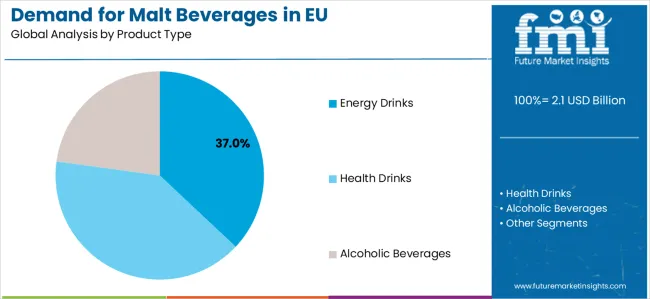
Health drinks applications are positioned to represent 37.0% of total European malt beverage demand in 2025, reflecting the segment's significant position within the overall market ecosystem and the substantially growing wellness consumption patterns compared to other product categories across most European countries.
This substantial market share directly demonstrates the exceptionally high adoption rates of health-focused malt beverages among European wellness-conscious consumers and the continuously expanding population of functional beverage enthusiasts across both Western and Eastern European markets.
Modern European health drink malt beverage applications are increasingly featuring sophisticated formulations that deliver enhanced nutritional profiles, targeted wellness benefits, and specialized functional properties specifically designed to address common health and lifestyle challenges including energy optimization, immune system support, digestive wellness, and overall vitality enhancement.
European consumers consistently demonstrate willingness to invest substantially in premium health-focused malt beverages that deliver visible wellness benefits, support optimal health outcomes, comply with EU health and safety standards, and provide consistent results for both daily consumption and specific wellness applications. Within the health drinks segment, functional wellness beverages command 22% share, nutritional supplements represent 10%, and specialized health formulations account for 5%, reflecting comprehensive product segmentation strategies tailored to European wellness market preferences.
The demand for malt beverages in EU is advancing steadily due to intensifying wellness beverage trends and growing recognition of functional drinking benefits across EU member states. The market faces challenges including fluctuating barley prices and raw material costs, complex alcohol regulations across diverse European jurisdictions, varying taste preferences across different consumer segments, competition from other functional beverages including kombucha and plant-based alternatives, and varying consumer awareness levels regarding malt beverage benefits despite growing health consciousness trends.
Innovation initiatives, craft brewing programs, functional enhancement solutions, and wellness positioning platforms continue to influence product development strategies and market evolution patterns across European beverage markets.
The rapidly accelerating adoption of craft brewing culture and artisanal beverage appreciation is fundamentally enabling broader market acceptance across European countries, enhanced consumer sophistication among beverage enthusiasts particularly regarding taste complexity and brewing craftsmanship, and significantly improved product positioning through certified craft brewing applications.
Advanced craft brewing platforms operated by specialized beverage artisans, professional brewers, and major craft beverage companies equipped with comprehensive brewing education in multiple European languages, taste profiling tools, brewing guides, and artisanal recommendations provide extensive consumer education resources while dramatically expanding product credibility across diverse beverage segments and geographic markets throughout the European Union.
These craft brewing trends prove particularly valuable for malt beverages that require detailed brewing process documentation, taste complexity verification, and targeted marketing approaches to effectively communicate complex artisanal benefits and justify premium pricing positions across sophisticated European beverage-conscious segments.
Craft brewing adoption also enables sophisticated taste analytics, personalized beverage recommendations based on individual taste preferences and consumption patterns, direct consumer feedback collection that informs product development, and craft experience models that ensure consumer engagement while building brand loyalty across fragmented European beverage markets.
Progressive European malt beverage manufacturers are systematically incorporating innovative functional ingredients including adaptogens, probiotics, vitamins, and natural energy enhancers that address growing European consumer demands for superior health benefits, consistent wellness outcomes, and enhanced functional properties in beverage products.
Strategic integration of these functional enhancement technologies, combined with rigorous efficacy testing and validation protocols conducted at European beverage research institutions, enables manufacturers to develop differentiated wellness propositions that appeal to health-conscious European consumers while maintaining essential taste characteristics and consumer acceptance.
These functional initiatives also support development of specialized formulations for specific wellness applications increasingly recognized across European markets, enhanced health options for targeted consumer segments recommended by European nutritionists, and scientifically-validated products that resonate with evidence-based consumer segments particularly prevalent in Nordic and Western European countries.
Technology investments in functional ingredient facilities established in Netherlands and Germany, precision formulation capabilities, and advanced malt beverage processing technologies enable European manufacturers to explore next-generation wellness beverages while maintaining competitive positioning in premium and health-focused market segments.
European consumers and beverage manufacturers are increasingly prioritizing sustainability and environmental responsibility when selecting malt beverages, driving fundamental changes in sourcing strategies across the European beverage industry. Companies are implementing comprehensive sustainable brewing systems using organic barley cultivation, reducing environmental impact through renewable energy utilization, and developing environmentally responsible supply chains that align with EU sustainability directives and corporate environmental responsibility regulations.
This trend is particularly pronounced across Nordic countries, Germany, Netherlands, and France where consumers demonstrate exceptional environmental consciousness and willingness to pay premiums for beverages with verified sustainability credentials and environmental compliance documentation.
Manufacturers are responding by developing partnerships with certified organic barley suppliers, implementing sustainable brewing programs, obtaining multiple environmental certifications including organic brewing standards and carbon-neutral production, and providing comprehensive environmental impact information that differentiates their products in increasingly competitive European markets emphasizing environmental responsibility and sustainable consumption commitments.
The demand for malt beverages in EU is projected to grow from USD 2.1 billion in 2025 to USD 5.89 billion by 2035, registering a CAGR of 9.3% over the forecast period. Germany is expected to maintain its leadership with a 24.7% share in 2025, supported by its expansive beer culture infrastructure and strong tradition of malt beverage consumption.
France follows with an 18.9% market share, attributed to growing demand for premium and artisanal beverage experiences. Italy contributes 16.2% of the market, driven by increasing adoption in wellness and functional beverage applications. Spain accounts for 11.4% of the market, while Netherlands represents 3.8%. The Rest of Europe region holds the remaining market share, encompassing Nordic countries, Eastern Europe, and other EU member states with emerging demand for malt beverage products.
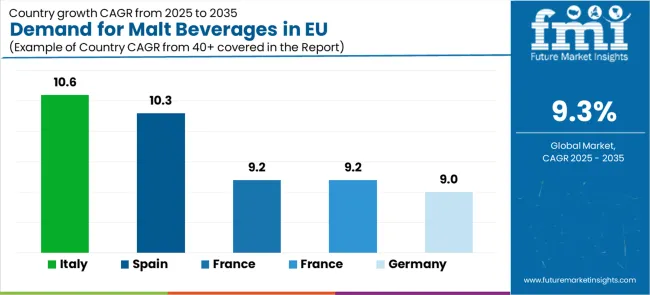
| Country | CAGR (2025-2035) |
|---|---|
| Italy | 10.6% |
| Spain | 10.3% |
| France | 9.2% |
| Netherlands | 9.2% |
| Germany | 9.0% |
The demand for malt beverages in EU demonstrates strong growth across major economies, with Italy leading at a 10.6% CAGR through 2035, driven by expanding wellness beverage culture and growing health consciousness. Spain follows at 10.3%, supported by craft brewing innovation and Mediterranean beverage traditions.
France and Netherlands grow at 9.2%, integrating malt beverages into sophisticated beverage culture and wellness practices. Germany maintains steady growth at 9.0%, leveraging its established beer and malt beverage infrastructure. Rest of Europe shows a decline at -1.7% CAGR, reflecting market consolidation.
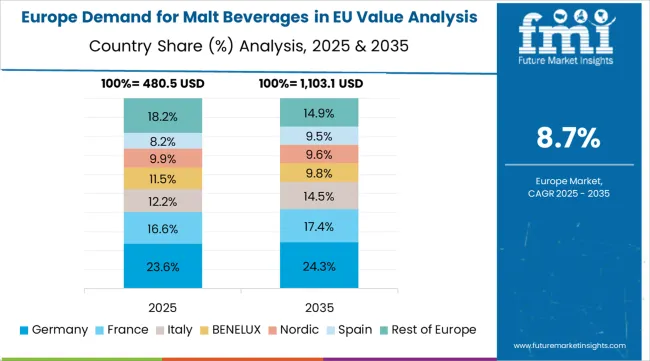
The malt beverages market in Germany is projected to exhibit steady growth with a CAGR of 9.0% through 2035, driven by exceptionally strong beer culture tradition and beverage infrastructure, comprehensively well-established distribution networks for malt-based products and specialty beverages, and sophisticated regulatory frameworks supporting beverage quality standards throughout the country.
Germany's advanced beverage regulations and internationally recognized brewing standards through organizations including German Brewers Association are creating substantial demand for certified premium malt beverages across diverse consumer and hospitality segments.
Major beverage companies including German breweries, specialized malt beverage manufacturers including craft producers, and professional distribution networks are systematically establishing extensive product portfolios serving both mainstream consumers and specialty beverage enthusiasts throughout German retail centers, hospitality venues, and consumer communities.
The German market benefits from exceptionally high consumer appreciation for beer and malt beverage quality, substantial brewing industry presence, strong retail distribution programs delivering variety at competitive pricing, and cultural emphasis on beverage craftsmanship that naturally support premium malt beverage adoption.
The demand for malt beverages in France is expanding at a robust CAGR of 9.2%, substantially supported by increasing French consumer interest in premium beverage experiences and artisanal drinking culture, growing awareness of craft brewing benefits, and sophisticated appreciation for beverage complexity reflecting French culinary culture. France's well-established culinary tradition and premium positioning strategies across beverage sectors are systematically driving demand for high-quality malt beverages across diverse consumer and hospitality segments.
Specialized beverage suppliers including French craft brewers, traditional beverage distributors, major retail chains (Carrefour, Auchan, Leclerc), and professional hospitality venues are establishing comprehensive product ranges featuring premium imported and French-produced malt beverages emphasizing quality and artisanal craftsmanship. The French market particularly benefits from strong cultural emphasis on beverage quality traditions, culinary pairing techniques, and traditional methods that align perfectly with malt beverages positioning as essential components for sophisticated drinking experiences.
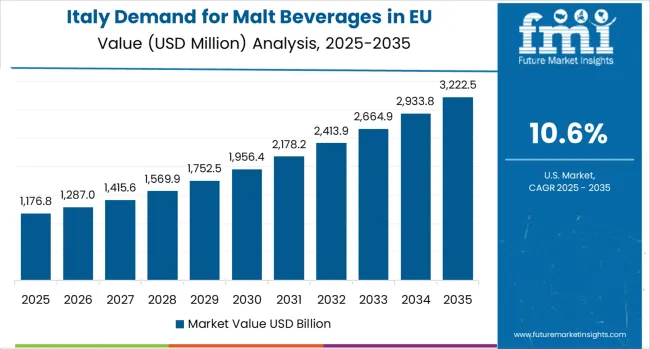
The demand for malt beverages in Italy is growing at a strong CAGR of 10.6%, fundamentally driven by rapidly expanding wellness beverage culture and health consciousness, growing recognition of functional beverage benefits, and strong Italian cultural appreciation for natural ingredients and traditional wellness approaches. Italy's established wellness culture is systematically incorporating malt beverages to enhance healthy lifestyle patterns, improve nutritional intake, and modernize traditional Italian wellness approaches while maintaining authentic cultural characteristics.
Health-focused retailers, specialized wellness beverage distributors including Italian suppliers, leading grocery retailers (Coop, Esselunga, Conad), and traditional wellness suppliers are strategically investing in education programs and taste demonstrations addressing growing Italian interest in functional malt beverage solutions. The Italian market particularly benefits from strong cultural appreciation for natural wellness solutions, traditional health-oriented lifestyle approaches reflecting established Italian wellness values, and growing wellness capacity particularly in Northern Italian regions supporting premium wellness product adoption.
Demand for malt beverages in Spain is projected to grow at a strong CAGR of 10.3%, substantially supported by rapidly expanding craft beverage sector that actively promotes artisanal malt applications, increasing Spanish consumer awareness of premium beverage experiences, and growing beverage consciousness particularly in major metropolitan areas including Madrid, Barcelona, Valencia, and Seville. Spanish craft beverage sector is experiencing significant innovation with expansion of craft brewers, premium beverage suppliers, and major hospitality distributors systematically increasing malt beverage category investments and introducing artisanal production capabilities.
The Spanish market is increasingly characterized by craft beverage trends reflecting broader European patterns, growing interest in malt beverage formulations addressing specific taste and wellness applications, and increasing acceptance of premium pricing for quality beverages delivering exceptional taste experiences. Spain's substantial hospitality industry potential, strong cultural appreciation for beverage innovation reflecting Mediterranean values, and expanding craft beverage infrastructure create favorable conditions for malt beverage market expansion.
Demand for malt beverages in the Netherlands is expanding at a robust CAGR of 9.2%, fundamentally driven by exceptionally strong Dutch commitment to sustainable beverage production, premium craft beverage solutions, and environmental consciousness that positions Netherlands among European sustainable beverage leaders. Dutch consumers and beverage professionals are increasingly selecting malt beverages based on comprehensive sustainability credentials, verified environmental production through European standards, and complete documentation demonstrating taste benefits and environmental profiles throughout production processes.
The Netherlands market significantly benefits from exceptionally well-developed sustainable beverage research infrastructure including major beverage innovation companies, specialized malt beverage suppliers, and professional sustainable distribution networks, combined with demonstrated willingness to invest substantial resources in malt beverages with verified sustainability certifications and quality standards. Dutch regulatory environment actively supports beverage innovation, malt beverage research development, transparent environmental claim requirements, and sustainability validation initiatives that enhance consumer confidence and market development.
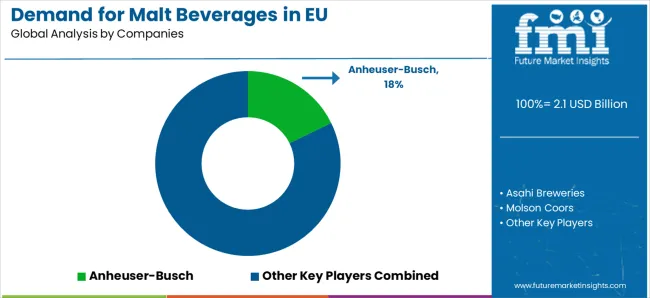
The demand for malt beverages in EU is defined by intense competition among multinational beverage corporations, regional European manufacturers, specialized craft brewers, and functional beverage companies from major beverage suppliers. Companies are investing in European brewing capacity expansion, advanced brewing technologies, craft beverage development through European innovation centers, sustainability solutions aligned with EU environmental directives, and direct-to-consumer distribution platforms serving diverse European beverage markets.
Strategic acquisitions, product portfolio expansion, geographic market penetration across Eastern European growth markets, professional beverage industry partnership programs, and sustainability certifications are central to strengthening market position and capturing share in this dynamic European category.
Major market participants include Anheuser-Busch with significant European market presence through brewing dominance and comprehensive malt beverage solutions distributed through European retail and hospitality channels.
Asahi Breweries maintains substantial European market leadership through premium positioning and diverse beverage applications across craft and mainstream sectors including consumer and hospitality markets. Molson Coors emphasizes craft and mainstream beverage technologies with technical support services for professional beverage retailers across European markets. Nestlé SA represents significant European functional beverage capabilities with specialized wellness-focused solutions and comprehensive beverage technologies.
Regional European producers and specialized craft brands are establishing significant market presence through premium positioning, sustainability certifications, specialty malt beverage formulations including organic alternatives and functional options, and direct-to-consumer business models.
Sustainability programs from major European beverage initiatives including established craft brewing programs provide environmentally responsible alternatives supporting market development, capturing meaningful market share particularly in sustainability-driven beverage markets. European co-brewing specialists including specialized malt processors operate comprehensive production facilities serving both branded manufacturers and beverage customers, representing critical infrastructure enabling market expansion and product innovation across European beverage markets.
| Item | Value |
|---|---|
| Quantitative Units | USD 5.2 billion |
| Nature | Conventional, Organic |
| Product Type | Energy Drinks, Health Drinks, Alcoholic Beverages |
| Distribution Channel | Specialty Stores, Supermarkets/Hypermarkets, Online Retail |
| Countries Covered | Germany, France, Italy, Spain, Netherlands, Rest of Europe |
| Key Companies Profiled | Anheuser-Busch, Asahi Breweries, Molson Coors, Nestlé SA, Bavaria Brewery, Carlsberg Group, Heineken, SABMiller, Constellation Brands, European Regional Craft Brewers |
| Additional Attributes | Dollar sales by nature, product type, and distribution channel, regional demand trends across Western and Eastern European beverage markets, competitive landscape analysis with multinational corporations and specialized European craft brands, consumer preferences for conventional versus organic formulations and wellness positioning, integration with European craft beverage trends and functional wellness strategies, innovations in brewing technologies and sustainability solutions aligned with EU beverage regulations, adoption of direct-to-consumer models and specialty beverage distribution networks across EU markets, regulatory framework analysis and beverage safety standards, supply chain optimization strategies including sustainable barley sourcing partnerships, and market penetration analysis for diverse consumer segments and geographic regions throughout European Union member states. |
The global demand for malt beverages in EU is estimated to be valued at USD 2.1 billion in 2025.
The market size for the demand for malt beverages in EU is projected to reach USD 5.2 billion by 2035.
The demand for malt beverages in EU is expected to grow at a 9.3% CAGR between 2025 and 2035.
The key product types in demand for malt beverages in EU are conventional and organic .
In terms of product type, energy drinks segment to command 37.0% share in the demand for malt beverages in EU in 2025.






Our Research Products

The "Full Research Suite" delivers actionable market intel, deep dives on markets or technologies, so clients act faster, cut risk, and unlock growth.

The Leaderboard benchmarks and ranks top vendors, classifying them as Established Leaders, Leading Challengers, or Disruptors & Challengers.

Locates where complements amplify value and substitutes erode it, forecasting net impact by horizon

We deliver granular, decision-grade intel: market sizing, 5-year forecasts, pricing, adoption, usage, revenue, and operational KPIs—plus competitor tracking, regulation, and value chains—across 60 countries broadly.

Spot the shifts before they hit your P&L. We track inflection points, adoption curves, pricing moves, and ecosystem plays to show where demand is heading, why it is changing, and what to do next across high-growth markets and disruptive tech

Real-time reads of user behavior. We track shifting priorities, perceptions of today’s and next-gen services, and provider experience, then pace how fast tech moves from trial to adoption, blending buyer, consumer, and channel inputs with social signals (#WhySwitch, #UX).

Partner with our analyst team to build a custom report designed around your business priorities. From analysing market trends to assessing competitors or crafting bespoke datasets, we tailor insights to your needs.
Supplier Intelligence
Discovery & Profiling
Capacity & Footprint
Performance & Risk
Compliance & Governance
Commercial Readiness
Who Supplies Whom
Scorecards & Shortlists
Playbooks & Docs
Category Intelligence
Definition & Scope
Demand & Use Cases
Cost Drivers
Market Structure
Supply Chain Map
Trade & Policy
Operating Norms
Deliverables
Buyer Intelligence
Account Basics
Spend & Scope
Procurement Model
Vendor Requirements
Terms & Policies
Entry Strategy
Pain Points & Triggers
Outputs
Pricing Analysis
Benchmarks
Trends
Should-Cost
Indexation
Landed Cost
Commercial Terms
Deliverables
Brand Analysis
Positioning & Value Prop
Share & Presence
Customer Evidence
Go-to-Market
Digital & Reputation
Compliance & Trust
KPIs & Gaps
Outputs
Full Research Suite comprises of:
Market outlook & trends analysis
Interviews & case studies
Strategic recommendations
Vendor profiles & capabilities analysis
5-year forecasts
8 regions and 60+ country-level data splits
Market segment data splits
12 months of continuous data updates
DELIVERED AS:
PDF EXCEL ONLINE
Europe Non-Alcoholic Malt Beverages Market Insights – Demand & Growth 2025–2035
Europe Malt Extract Market Growth & Demand Forecast 2017-2027
Non-Alcoholic Malt Beverages Market Size, Growth, and Forecast for 2025 to 2035
Industry Share & Competitive Positioning in Non-Alcoholic Malt Beverages
Demand for Isomalt in EU Size and Share Forecast Outlook 2025 to 2035
UK Non-Alcoholic Malt Beverages Market Analysis from 2025 to 2035
Isomalt Industry Analysis in Western Europe – Size, Share & Forecast 2025 to 2035
USA Non-Alcoholic Malt Beverages Market Insights – Trends, Demand & Growth 2025-2035
ASEAN Non-Alcoholic Malt Beverages Market Trends – Demand & Forecast 2025–2035
Demand for Fusion Beverages in EU Size and Share Forecast Outlook 2025 to 2035
Australia Non-Alcoholic Malt Beverages Market Insights - Trends & Forecast 2025 to 2035
Latin America Non-Alcoholic Malt Beverages Market Trends – Growth & Forecast 2025–2035
Demand for Digestion Resistant Maltodextrin in EU Size and Share Forecast Outlook 2025 to 2035
Digestion-Resistant Maltodextrin Industry Analysis in Western Europe - Growth & Market Insights 2025 to 2035
Malt Sprouts Market Size and Share Forecast Outlook 2025 to 2035
Europe Radiotherapy Patient Positioning Market Size and Share Forecast Outlook 2025 to 2035
Europe Polyvinyl Alcohol Industry Analysis Size and Share Forecast Outlook 2025 to 2035
Europe Cruise Market Forecast and Outlook 2025 to 2035
Europium Market Forecast and Outlook 2025 to 2035
Malted Rye Flour Market Size and Share Forecast Outlook 2025 to 2035

Thank you!
You will receive an email from our Business Development Manager. Please be sure to check your SPAM/JUNK folder too.
Chat With
MaRIA